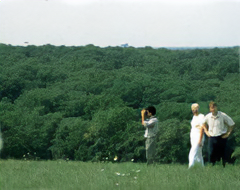Research > Tree Swallows (Tachycineta bicolor)
Native America initiated a cooperative effort with the Town of Oyster Bay, NY in 1996 to put up nest boxes for Bluebirds and Tree Swallows on one of the capped landfills in the town. Native America provided field and design guidance and, together with the town, put up 100 nest boxes on the grassy hills. This site has proved invaluable for ornithological studies. The area is desolate, secured from vandalism and inviting to cavity nesting birds. The town has taken an interest in the site as a wildlife refuge and the site has become one of Native America's prime research locations for variations on nest box design. Monitoring of the nest boxes is shared between the town and Native America.
Photo by Gregory K. Scott
1
Tree Swallows are among those birds that are harassed and killed by the aggressive house sparrow. In an effort to explore alternative nesting structures that might diminish the use by house sparrows, one hundred nest boxes were put up on a landfill with the cooperation of the Town of Oyster Bay.
Image: Tree swallows in flight near nest box.
2
The town provided staff to monitor the nest boxes since 1996 and found that with open top nest boxes the numbers of young tree swallows doubled each year with seventy five fledging in 1998. (While, at the present, there are no bluebirds found in this area of Long Island, NY, any bluebird reading this is most welcome to join the study.)
Image: Monitors for nest box research area.
3
The first part of the study is primarily concerned with the adaptability and breeding success of the native tree swallows. While there are house sparrows in the area, none were found in any of the nest boxes. However, the study site chosen is a remote elevated field and it may be that the house sparrows would not venture there anyway. This aspect will,in turn, be explored.
Image: Grid of nest boxes in research area.




